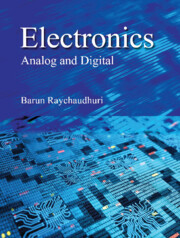Book contents
Summary
The bipolar transistor is, no doubt, a nonlinear device. However, under certain conditions, it may be made to act as a linear device, as mentioned in Chapter 6. The present chapter explains how the well-known circuit theorems, such as Thevenin's theorem and Norton's theorem, meant for linear circuits can be applied to transistor operations with the assumption of a two-port device model. A suitable set of circuit parameters, known as hybrid parameters, are introduced in order to derive more accurate expressions for the voltage and current gains of a transistor and its other parameters. Also the frequency dependence of the transistor gain is explained in terms of the hybrid parameters.
Thevenin's Theorem
It is a very useful theorem for simplifying electrical circuits. It states that any two terminals of a linear network can be substituted by a single voltage source equal to the open circuit voltage between those two terminals in series with a single resistance equal to the equivalent resistance appearing between the two open terminals when all voltage and current sources related to the circuit are replaced by their internal resistances.
The above mentioned open circuit voltage is termed as Thevenin voltage and the equivalent resistance is called Thevenin resistance. An ideal voltage source is replaced by a short circuit and an ideal current source is replaced by an open circuit. The properties of voltage and current sources may be recalled from Chapter 1. Now let us have some practical idea about this theorem using the circuit of Figure 7.1(a). Suppose the current through the load resistor (RL) is to be determined. It is not too difficult to do that with the present circuit. However, one can simplify it further through the following steps using Thevenin's theorem.
Step-1: Terminals P and Q are made open to detach RL and the circuit looks like that of Figure 7.1(b). We proceed with this circuit.
Step-2: The current through R2 is V/(R1 + R2) so that the Thevenin voltage across R2 is
Step-3: The voltage source (V), assumed to be ideal is replaced by short circuit so that the circuit gets modified to that of Figure 7.1(c). The Thevenin resistance between terminals P and Q is
Step-4: The simplified circuit between P and Q is similar to that of Figure 7.1(d) having the Thevenin equivalent voltage source in series with the Thevenin resistance.
- Type
- Chapter
- Information
- Electronics , pp. 200 - 238Publisher: Cambridge University PressPrint publication year: 2023



